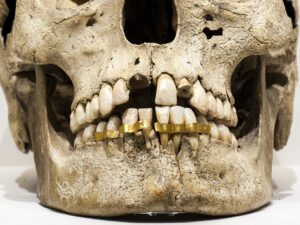For all of human history, people have been losing their teeth and using creative solutions to replace them. The history of dental implants reveals a fascinating picture of how dentistry has evolved over the millennia, not to mention how far modern implants have come from their humble beginnings.
When Were Dental Implants Invented?
How long have dental implants been available? It’s impossible to know for sure, but the history of dental implants stretches back thousands of years. Across the entire world, many civilizations have used a wide variety of materials to create dental implants. As early as 4,000 BC, people in China used carved bamboo pegs to replace their missing teeth by fixing them to the bone in the mouth. In 2500 BC, records suggest that Ancient Egyptians used a similar technique using implants crafted out of precious metals, as well as gold ligature wire to stabilize periodontally involved teeth. Mayan teeth implants carved from shells were some of the most successful types of historic dental implants. When researchers discovered a skeleton from 600 AD with such implants, the jawbone appeared to have correctly healed around them.
Looking back, it’s incredible to think of how resourceful ancient dentists needed to be. Materials for these ancient implants ranged from carved bone and ivory to metal or even jewels. However, without access to modern painkillers or anesthesia, it’s reasonably certain that the history of dental implants was fraught with pain. We can all be grateful that modern technology has made dental implants so much safer!
Modern Dental Implants are Safe and Comfortable
Though the original inventor of dental implants has been lost to history, many people have continued to shape the field of tooth implant design. In the 1930s, Drs. Alvin and Moses Strock experimented with a chromium-cobalt alloy called Vitallium to anchor tooth implants and used screw fixtures to firmly attach them to the jaw and allow the bone to grow into the metal. By using a biocompatible metal, this technique found greater success. One of the main problems with implants up to that point was that not all implants would properly bond to the jawbone. Metals especially could not bind to bone and ultimately might cause infection or rejection. But in 1952, Dr. Brånemark discovered that titanium could successfully attach to bone and therefore was crucial in long-lasting and safer dental implants. He coined the term “osseointegration,” which describes the process of bone tissue integrating with foreign material.
These discoveries revolutionized tooth implant design and set the stage for modern implants. With a greater understanding of how to create long-lasting dental implants that the body wouldn’t reject, the field continued to refine and create even safer, less invasive, and more comfortable implants.
From its humble roots in the wooden implants of 4,000 BC China, the field of modern dental implants has come a long way. If you’ve lost or damaged a tooth, you’ll be glad to know that modern technology makes dental implants a safe and convenient option. If you have any more questions about the modern process of getting a dental implant or would like to schedule an appointment, reach out to our team here at Pinnacle Dental Associates today.



